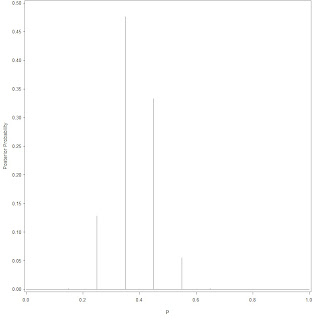原来作者的R Code:
p = seq(0.05, 0.95, by = 0.1)
prior = c(1, 5.2, 8, 7.2, 4.6, 2.1, 0.7, 0.1, 0, 0)
prior = prior/sum(prior)
data = c(11, 16)
post = pdisc(p, prior, data)
round(cbind(p, prior, post),2)
library(lattice)
PRIOR=data.frame("prior",p,prior)
POST=data.frame("posterior",p,post)
names(PRIOR)=c("Type","P","Probability")
names(POST)=c("Type","P","Probability")
data=rbind(PRIOR,POST)
xyplot(Probability~P|Type,data=data,layout=c(1,2), type="h",lwd=3,col="black")
对应的SAS Code:
options fullstimer formchar='|----|+|---+=|-/\<>*' formdlim='-' error=3;
/***************************************************/
/*
模仿oloolo大牛的程序。把 Bayesian compution with R 中的例子用SAS写出来;
原文为oloolo所写;
用来练习,写不出来的,就看看oloolo怎么写的;
哈哈 :)
*/
/*
The following is to draw the graph for the discrete prior;
There are ten points that p may take, each with its weight respectively;
*/
data p;
do p = .05 to .95 by .1;
output;
end;
run;
data prior;
input prior @@;
cards;
1 5.2 8 7.2 4.6 2.1 .7 .1 0 0
;
run;
data p;
retain sum_prior 0;
do until (eof1);
set prior end = eof1;
sum_prior + prior;
end;
do until (eof2);
merge p prior end = eof2;
prior = prior/sum_prior;
output;
end;
drop sum_prior;
run;
goptions reset = all;
symbol interpol=Needle value=none line=1 color=black;
axis1 label = (angle = 90 'Prior Probability') order = (0 to 0.3 by .05) minor = none;
axis2 label = ('p') order = (0 to 1 by .2) minor = none;
proc gplot data = p;
plot prior*p / vaxis=axis1 haxis=axis2;
run;
quit;

/*
Next is to calculate the posterior and then draw it;
*/
%let n0=16;
%let n1=11;
/*
Calculate the log-likelihood
*/
data p;
set p;
if p > 0 and p < 1 then do;
log_like = log(p)*&n1 + log(1-p)*&n0;
end;
else
log_like = -999*(p=0)*(&n1 > 0) + (p=1)*(&n0 > 0) ;
run;
/*
Calculate the max(log-likelihood). Since exp(log_likelihood) is very colse to 0, if use it directly, almost all
calculated items is zero. So, use exp(log_likelihood - max), sacle the likelihood. It doesn't change the value
of likelihood since final likelihood = likelihood / sum(likelihood). If both numerator and denominator both
scaled by the same number, it doesn't change the fraction value.
*/
proc means data = p noprint;
var log_like;
output out = _max max(log_like)=max;
run;
data p;
set _max;
sum_like = 0;
do until (eof);
set p end = eof nobs = ntotal;
likelihood = exp(log_like - max);
sum_like + likelihood;
end;
do until (eof1);
set p end = eof1;
likelihood = exp(log_like - max)/sum_like;
posterior = likelihood * prior;
output;
end;
run;
data p;
sum_post = 0;
do until (eof);
set p end = eof;
sum_post + posterior;
end;
do until (eof2);
set p end = eof2;
posterior = posterior / sum_post;
output;
end;
run;
goptions reset = all;
symbol interpol=Needle value=none line=1 color=black;
axis1 label = (angle = 90 'Posterior Probability') order = (0 to 0.5 by .05) minor = none;
axis2 label = ('p') order = (0 to 1 by .2) minor = none;
proc gplot data = p;
plot posterior*p / vaxis=axis1 haxis=axis2;
run;
quit;

sas set options for details:
ReplyDeletehttp://www.technion.ac.il/docs/sas/lgref/z0173782.htm